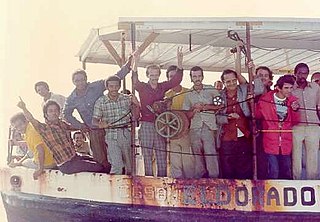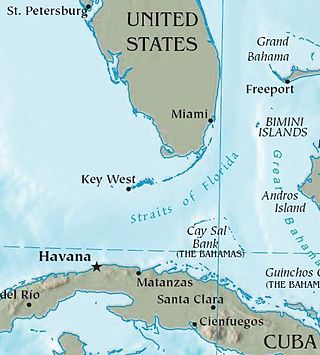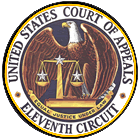
The Mariel boatlift was a mass emigration of Cubans who traveled from Cuba's Mariel Harbor to the United States between April 15 and October 31, 1980. The term "Marielito" is used to refer to these refugees in both Spanish and English. While the exodus was triggered by a sharp downturn in the Cuban economy, it followed on the heels of generations of Cubans who had immigrated to the United States in the preceding decades.

The wet feet, dry feet policy or wet foot, dry foot policy was the name given to a former interpretation of the 1995 revision of the application of the Cuban Adjustment Act of 1966 that essentially says that anyone who emigrated from Cuba and entered the United States would be allowed to pursue residency a year later. Prior to 1995, the U.S. government allowed all Cubans who reached U.S. territorial waters to remain in the U.S. After talks with the Cuban government, the Clinton administration came to an agreement with Cuba that it would stop admitting people intercepted in U.S. waters. For two decades thereafter, any Cuban caught on the waters between the two nations would summarily be returned to Cuba or sent to a third country, while one who made it to shore got a chance to remain in the United States, and later would qualify for expedited "legal permanent resident" status in accordance with the 1966 Act and eventually U.S. citizenship. However, the policy came with increased risk for asylum seekers entering the country. In 1994, also known as the year of the Rafter Crisis, 36,900 immigrants risked travel by sea. On January 12, 2017, Barack Obama announced the immediate end of the policy following concerns about the safety of immigrants risking their lives to cross the straits of Florida into the U.S. The end of his presidency saw an increase in foreign relations with Cuba, including bilateral agreements with the Cuban government regarding maritime and aeronautical search and rescue protocols for Cuban immigrants entering the country.

The Cuban exodus is the mass emigration of Cubans from the island of Cuba after the Cuban Revolution of 1959. Throughout the exodus, millions of Cubans from diverse social positions within Cuban society emigrated within various emigration waves, due to political repression and disillusionment with life in Cuba.

The Illegal Immigration Reform and Immigrant Responsibility Act of 1996 made major changes to the Immigration and Nationality Act (INA). IIRIRA's changes became effective on April 1, 1997.

In Canada, a security certificate is a legal mechanism by which the Canadian government can detain and deport permanent residents and all other non-citizens living in Canada.
An Application for Waiver of Grounds of Inadmissibility is an application for legal entry to the United States made by an individual who is otherwise inadmissible on one or more grounds. The application is submitted to the consular office, U.S. Citizenship and Immigration Services office or immigration court considering the immigrant visa or adjustment of status application.

Garcia-Mir v. Meese, 788 F.2d 1446, was a decision by the Eleventh Circuit Court of Appeals, which ruled that the United States could indefinitely detain Cuban refugees who had arrived during the 1980 Mariel boatlift.
Adjustment of status in the Immigration and Nationality Act (INA) of the United States refers to the legal process of conferring permanent residency upon any alien who is a refugee, asylum seeker, nonpermanent resident, conditional entrant, parolee, and so forth.
Title 8 of the United States Code codifies statutes relating to aliens and nationality in the United States Code.
Immigration and Naturalization Service v. St. Cyr, 533 U.S. 289 (2001), is a United States Supreme Court case involving habeas corpus and INA § 212(c) relief for deportable aliens.
Reno v. Flores, 507 U.S. 292 (1993), was a Supreme Court of the United States case that addressed the detention and release of unaccompanied minors.
Under the public charge rule, immigrants to United States classified as Likely or Liable to become a Public Charge may be denied visas or permission to enter the country due to their disabilities or lack of economic resources. The term was introduced in the Immigration Act of 1882. The restriction has remained a major cause for denial of visas and lawful permanent residency ever since; in 1992, about half of those denied immigrant and non-immigrant visas for substantive reasons were denied due to the public charge rule. However, the administrative definition of "public charge" has been subject to major changes, notably in 1999 and 2019.

The United States government holds tens of thousands of immigrants in detention under the control of Customs and Border Protection and the Immigration and Customs Enforcement (ICE). Immigrants are detained for unlawful entry to the United States, when their claims for asylum are received, and in the process of deportation and removal from the country. During Fiscal Year 2018, 396,448 people were booked into ICE custody: 242,778 of whom were detained by CBP and 153,670 by ICE's own enforcement operations. A daily average of 42,188 immigrants were held by ICE in that year. In addition, over twelve thousand immigrant children are housed by facilities under the supervision of the Office of Refugee Resettlement's program for Unaccompanied Alien Children. Prior to referral to these other agencies, the CBP holds immigrants at processing centers; between mid-May and mid-June 2019, it held between 14,000 and 18,000 immigrants.
Zadvydas v. Davis, 533 U.S. 678 (2001), was a case decided by the Supreme Court of the United States. The court ruled that the plenary power doctrine does not authorize the indefinite detention of immigrants under order of deportation whom no other country will accept. To justify detention of immigrants for a period longer than six months, the government was required to show removal in the foreseeable future or special circumstances.
Immigration and Naturalization Service v. Delgado, 466 U.S. 210 (1984), was a United States Supreme Court decision on the limits of worksite enforcement by immigration agents. Specifically, the Court ruled that factory raids by the Immigration and Naturalization Service (INS) were not illegal seizures under the Fourth Amendment to the U.S. Constitution.
Expedited removal is a process related to immigration enforcement in the United States where an alien is denied entry to and/or physically removed from the country, without going through the normal removal proceedings. The legal authority for expedited removal allows for its use against most unauthorized entrants who have been in the United States for less than two years. Its rollout so far has been restricted to people seeking admission and those who have been in the United States for 14 days or less, and excludes first-time violators from Mexico and Canada.
Nielsen v. Preap, No. 16-1363, 586 U.S. ___ (2019), was a United States Supreme Court case related to the detention of legal immigrants with criminal histories. In a 5–4 vote, the Court ruled that the government has the power to detain immigrants at any time that have committed certain crimes that could lead to their deportation, even if those crimes occurred long in the past.
The Fort Chaffee crisis occurred during the Mariel boatlift in 1980 when over 19,000 Cuban refugees were detained at Fort Chaffee. They could not be released into the public because they were not United States citizens. After a promise of quick release many processing setbacks occurred and many refugees remained still detained at the center. Frustrated with the conditions at the facility and the slow processing many refugees rioted, 62 refugees were injured and 46 others were arrested. Refugees at the center would go on to refer to the riot as El Domingo. After the riots Governor Bill Clinton put heavy fortifications at the center. Clinton would lose the later Arkansas election after his opponent would use the incident against him.
Department of Homeland Security v. Thuraissigiam, 591 U.S. ___ (2020), was a United States Supreme Court case involving whether the Illegal Immigration Reform and Immigrant Responsibility Act of 1996, which limits habeas corpus judicial review of the decisions of immigration officers, violates the Suspension Clause of Article One of the U.S. Constitution. In the 7–2 opinion, the Court ruled that the law does not violate the Suspension Clause.

On April 1, 1980, six Cuban citizens made their way into the Peruvian embassy in Havana, Cuba, instigating an international crisis over the diplomatic status of around 10,000 asylum-seeking Cubans who joined them over the following days. The Peruvian ambassador, Ernesto Pinto Bazurco Rittler, spearheaded the effort to protect Cubans, most of whom were disapproved of by Fidel Castro’s regime and were seeking protection at the embassy. This episode marked the start of the Cuban refugee crisis, which was followed by a series of diplomatic initiatives between various countries in both North and South America that tried to organize the fleeing of people from the island of Cuba to the United States and elsewhere. The embassy crisis culminated with the substantial exodus of 125,266 Cuban asylum-seekers during the Mariel Boatlift.






